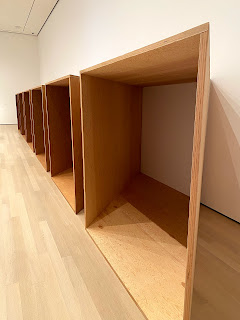 |
The Insectarium is housed in the Old Customs House
on Canal Street in New Orleans |
On the first floor of the Custom House on Canal Street in New Orleans, the Audubon Institute opened the city’s first insectarium. For twelve years the insectarium has been in the works behind the scenes and finally opened its doors to the public last week. I went with my cousin Ian on Tuesday to visit the array of ants, patent leather beetles, butterflies, and katydids.
 |
| Ants go marching . . . |
I was impressed by the ant farm. Along a wall in the museum’s main hallway has been constructed a sizable ant farm that spans about ten or more feet (I’m just guessing here). I was ready to spot the queen ant in her chambers but I could not find her but one of the museum volunteers told me that she is known to appear every once in a while but is usually surrounded by her ardent followers. Apparently, she is moved from chamber to chamber every once in a while and the lucky visitor who happens to be present can witness the event, but alas we were not fortunate enough to witness the royal entourage.
On the day we visited the insectarium, the black widow spider seemed to be missing. Ian and I looked for her but we could not find her, only an empty web. Hopefully, she did not escape! We informed the entomologist standing nearby and he said they were aware of the fact and were hoping she was hiding and not escaping.
Of course, the insectarium boasts the usual array of bugs: spiders, cockroaches, beetles galore, including the impressive diving beetle. One of the nice things about the insectarium is that it provides a place to view all of these bugs without fighting the urge to stomp on one of them. Probably, if I ever see a black widow spider coming my way, I am not going to point at it red belly and say, “look at that hour-glass shape, how fascinating!” I am going to either run away or defend myself. At the insectarium, however, the need for man to defend himself in his natural environment goes away, and I can safely admire the termites and cockroaches, without wondering if I should call Terminix (who happens to be a major sponsor for the insectarium).
 |
| Kids gawk at the Insectarium |
I could have done without Joan Riversfly done up like a bug and yakking about insects on a big screen TV. And I did think some of the exhibits were lackluster, especially the underground gallery which was supposed to make you feel like you were bug-sized. Either I didn’t get it or my imagination has run dry. Also, the honey bee exhibit should be at the same size as the ant farm: huge. But, hey, it was still cool watching a few bees gather their nectar and return to a very small hive.
The most impressive gallery was the butterfly gallery. The first part is the metamorphosis gallery. Here, you can see all the stages in their natural glory. It was really fascinating to look at the butterflies lined up in their various stages of metamorphosis. It still boggles my mind that a caterpillar can change from a lumpy piece of fat into a diaphanous spectacle in a matter of days. Wow.
 |
| A museum interpreter answers questions. |
I think of metamorphosis as a different form of birth, I guess. The human baby comes out of the womb wet and hairless and over time grows up and after a while looks quite different from the infant he or she once was. But with a caterpillar, it is quite a different story. They basically turn from one species to another. But, I guess it would be like if a human baby was born looking like a fetus. When it was born it would pretty much act like a caterpillar: slow-moving and eating a lot. In the human’s case that would mean a plentitude of milk and baby food as it fattened up and then curled up into a leathery cocoon for a few weeks only to emerge a post-pubescent, adult-ready human. Mothman, anyone? I am kind of glad, though that puberty is not as bad as metamorphosis would probably be. Can you imagine how embarrassing it would be if you entered the pupa stage like in the middle of gym class? Gross …
 |
|
Can you name the butterflies? |
After the metamorphosis gallery, we were gladly marshaled into the butterfly gallery where you can watch the insects flutter about in an oriental style garden complete with music and coy fish swimming in an ornate pond. It was a nice way to end the visit to the museum.
I highly recommend this museum. It is fun and freaky. I think any age group would find it interesting and enjoyable. The price is about 15 dollars for adults and I forget how much it is for children under the age of twelve, but hey, I was not looking. You can get an insectarium + zoo + aquarium package but I would not rush your insect trip. Take your time and enjoy the bugs!
























